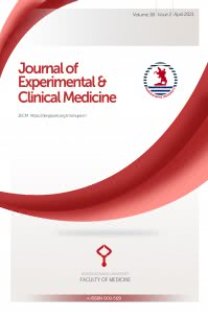Akne vulgaris tedavisinde tretinoin %0.025 jel ve adapalene %0.1 jelin klinik etkilerinin karşılaştırılması
Akne vulgaris, Tretinoin, Anti-enflamatuvar ajanlar, steroid olmayan, Dermatolojik ajanlar, İlaç uygulama programı, İlaç tedavisi
Comparison of clinical efficacy of tretinoin 0.025% gel and adapalene 0.1% gel in the treatment of acute vulgaris
Acne Vulgaris, Tretinoin, Anti-Inflammatory Agents, Non-Steroidal, Dermatologic Agents, Drug Administration Schedule, Drug Therapy,
___
1. Strauss JS, Thiboutot DM. Diseases of the sebaceous glands. In: Fitzpatrik TB, Freedberg IM, Wolff K, et al (eds.) Dermatolgy in General Medicine (5th ed.). Vol. 1. New York, Mc Graw-Hill Co, 1999; 769-784. 2. Tolman EL. Acne and acneiform dermatoses. In: Moshella SL, and Hurley HJ (eds.) Dermatology (3th ed). Vol 2. Philedelphia, W.B. Sounders Company, 1992; 1477-1492. 3. Arnold HL, Odom RB, James WD. Andrew's Diseases of the Skin. 4th ed. Philadelphia, London. W.B. Sounders Company, 1990; 250-267. 4. Leyden JJ. Topical treatment of acne vulgaris: Retinoids and cutaneous irritation. J Am Acad Dermatol 1998: 38 (suppl.): 1-4. 5. Erdi H. Aknede retinoid tedavisi. Memişoğlu HR, Acar MA, Aksungur ve arkadaşları (ed.) "2. Çukurova Dermatoloji GünlerTnde, 1. baskı. Adana, Çukurova Üniversitesi Basımevi, 1998; 53-60. 6. Weiss SJ, Shovin SJ. Adapalene for the treatment of acne vulgaris. J Am Acad Dermatol 1998; 39: 50-54. 7. Ellis CN, Millikan LE, Smith EB, et al. Comparison of adapalene 0.1% solution and tretinoin 0.025% gel in the topical treatment of acne vulgaris. Br J Dermatol 1998; 139 (suppl. 52): 41-47. 8. Thibooutot DM. Acne an overview of cilinical research findings. Dermatol Clin 1997; Vol 15: 1: 97-109. 9. Shroot B, Michel S. Pharmacology and chemistry of adapalene. J Am Acad Dermatol 1997; 36: 96-103.10. Russell JJ. Topical therapy for acne. Am Fam Physician 2000; 61: 357-366. 11. Alirezai M. Meynadier J. Jablonska S, et al. Efficacy and safety comparison study of 0.1% and 0.03% adapalene gels and 0.025% tretinoin gel in the topikal treatment of acne. Ann Dermatol Venereol 1996; 123: 165-170. 12. Cunliffe WJ, Capuho R, Dreno B, et al. Efficacy and safety comparison of adapalene (CD 271) gei and tretinoin gel in the topical treatment of acne vulgaris. A European multicentre trial. J Dermatol Treat 1997; 8: 173-178. 13. Grosshans E, Marks R, Mascaro JM, et al. Evaluation of clinical efficacy and safety of adapalene 0.1% gel versus tretinoin 0.025% gel in the treatment of acne vulgaris, with particular referance to the onset of action and impact on quality of life. Br J Dermatol 1998; 139 (suppl. 52): 26-33. 14. Cunliffe WJ, Capuho R, Dreno B, et al. Clinical efficacy and safety comparison of adapalene gel and tretinoin gel in the topical treatment of acne vulgaris. Europe and US multicenter trials. J Am Acad Dermatol 1997; 36: 126-134. 15. Shalita A, Weiss JS, Chalker DK, et al. A comparison of the efficacy and safety of adapalene gel 0.1% and tretinoin gel 0.025% in the treatment of acne vulgaris: A multicenter trial. J Am Acad Dermatol 1996; 34: 482-485. 16. Galvin SA, Gilbert R, Baker M, et al. Comparitive tolerance of adapalene 0.1 %gel and six different tretinoin formulations. Br J Dermatol 1998; 139 (suppl. 52): 34-40. 17. Verschoore M, Poncet M, Czernielewski J, et al. Adapalene 0.1% gel has low skin irritation potential. J Am Acad Dermatol 1997; 36: 104-109. 18. Caron D, Sorba V, Kerrouche N et al. Split-face comparision of adapalene 0.1% gel and tretinoin 0.025% gel in acne patients. J Am Acad Dermatol 1997; 36: 110-112. 19. Clucas A, Verschoore M, Sorba V et al. Adapalene 0.1% gel better tolerated than tretinoin 0.025% gel in acne patients. J Am Acad Dermatol 1997; 36: 116-118. 20. Caron D, Sorba V, Clucas A et al. Skin tolerance of adapalene 0.1% gel in combination with other topical antiacne treatments. J Am Acad Dermatol 1997; 36: 113-115. 21. Peck GL, DiGiovanna JJ. The retinoids. In: Fitzpatrik TB, Freedberg IM, Wolff K, et al (eds.) Dermatolgy in General Medicine (4th ed.). Vol. 2. New York, Mc Graw-Hill Co, 1993; 2883-2908. 22. Kong S, Voorhees JJ. Topical Retinoids. In: Fitzpatrik TB, Freedberg IM, Wolff K, et al (eds.) Dermatology in General Medicine (5th ed). Vol. 2. New York, Mc Graw-Hill Co, 1999; 2726-2733. 23. Shroot B. Pharmacodynamics and pharmacokinetics of topical adapalene. J Am Acad Dermatol 1998; 39: 17-24. 24. Michel S, Jomard A, Demarchez M. Pharmacology of adapalene. Br J Dermatol 1998; 139 (suppl.52): 3-7.
- ISSN: 1300-2996
- Yayın Aralığı: Yılda 4 Sayı
- Başlangıç: 2018
The effects of low pH on nitric oxide (NO) synthesis from human monocyte derived macrophages
AHMET YILMAZ ÇOBAN, BORA EKİNCİ, ASUMAN BİRİNCİ, Belma DURUPINAR, Murat ERTÜRK
Gülendam BOZDAYI, Ayşe KALKANCI, Aydan BİRİ, Semra KUŞTİMUR
Investigation of DNA damage in epileptic women treated with phenobarbital
Metin DENLİ, Ruşen DÜNDARÖZ, Cemal AKAY, Tayfun GÜNGÖR, Halil İbrahim AYDIN, Volkan BALTACI
C. Türkay YALIN, Burhan YAZICI, Levent YILDIZ, Necati ÖZEN, İlkay Koray BAYRAK
Valproic acid-induced neutropenia
Fatma AYDIN, Tayyar CANTÜRK, Nilgün ŞENTÜRK, Ahmet Yaşar TURANLI
Üriner tüberkülozda intravenöz ürografi bulguları ve tanıya katkısı
Murat GÜLER, Murat DANACI, Ümit BELET, Çetin ÇELENK
Beyin apselerinin cerrahi tedavisinde intraoperatif ultrasonografi kullanılması
Cengiz ÇOKLUK, Alpaslan ŞENEL, Ömer İYİGÜN, Mustafa ARAS, ARİF ÖNDER, Cemil RAKUNT, Fahrettin ÇELİK
